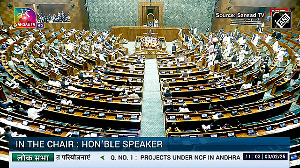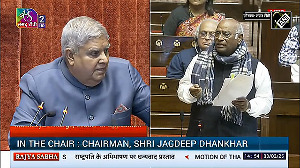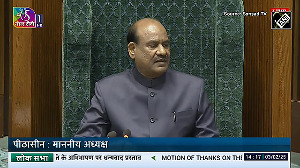The government had breached its fiscal deficit target given in the Budget for 2017-18 in November itself, touching 112 per cent of the limit.
Illustration: Uttam Ghosh/Rediff.com

Instead of the earlier aim of a fiscal deficit not exceeding three per cent of gross domestic product (GDP) for 2018-19, the government’s Budget makers are considering a 3.2 per cent of GDP target, which is also the aim for the ongoing year, 2017-18.
In what will be the last full Union Budget before the general election of 2019, Finance Minister Arun Jaitley will need some additional spending room.
While the coming Budget is not expected to be an outright populist document, there could be substantial increases in allocation to rural and social sector-focused schemes.
“With the tight fiscal situation, one of the realistic and rational options is maintaining 3.2 per cent of fiscal deficit next fiscal.
"Even if we achieve 3.2 per cent this year, the spending requirement for next year might make it pragmatic to defer the fiscal consolidation target by a year or so,” said an official in the know.
“Irrespective of what happens with the fiscal deficit this year, all bets are off next year.
"The government might not be bound by any fiscal restraint for a number of reasons,” said a member of the economic advisory council to the prime minister.
The person added that in spite of additional borrowing by the Centre this year, 3.2 per cent could still be achieved in 2017-18.
“But, that still does not discount a need for deviation from the fiscal road map next year.”
The government had breached its fiscal deficit target given in the Budget for 2017-18 in November itself, touching 112 per cent of the limit.
This is the highest deviation from the Budget Estimates (BE) for the fiscal deficit in the first eight months of a financial year since 2008-09, the year of the global financial crisis.
The Centre has opted for an additional borrowing of Rs 50,000 crore this financial year, through dated government securities, over and above the BE of Rs 5.8 lakh crore for 2017-18.
The Centre did say it was lowering its treasury bill borrowing by about Rs 61,000 crore but this has no impact on the deficit.
“With the fiscal deficit this year expected to be around 3.5 per cent of GDP, if not more, the government might target 3.2 per cent of GDP in the pre-election year,” said Madan Sabnavis, chief economist at CARE Ratings.
A former official who helped draft Budgets in the past said the 2018-19 one would probably have more spending on agriculture, irrigation, rural development, poverty reduction, rural housing, job creation and in infrastructure sectors like highways.
During the April-November period, the revenue deficit was 152 per cent of the Rs 3.2 lakh crore full-year target, compared with 98 per cent during the corresponding period last year.
This means the quality of the fiscal deficit is also poor, since much of the excess spending is not going into asset creation.
For this year, the Centre is staring at a tax revenue shortfall of Rs 40,000-50,000 crore.
It is also under pressure regarding some non-tax revenue items, with the exception of divestment.
While direct tax collection might see a shortfall of Rs 20,000 crore due to corporate slowdown, a Rs 25,000-30,000-crore shortage is expected in indirect tax revenue due to the recently introduced goods and services tax (GST).
“We could be looking at shortfalls in GST collections, dividends from public sector enterprises and state-owned banks, and likely in direct tax revenue as well,” another official said.












 © 2025
© 2025